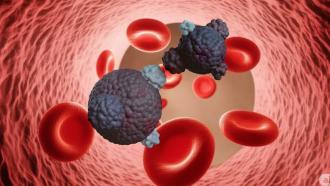
Cancer, a condition where healthy cells in the body grow out of control and instead of undergoing programmed death, keep multiplying without a check, has now become quite widespread. Most of us are familiar with the disease either through personal experience or a loved one battling it. Although the earliest records of cancer were found in the Egyptian mummies as old as 1600 BC, scientists across the world are still grappling to find a perfect ‘cure’ for this condition that is responsible for every sixth death in the world.
Among the 100 different types of cancers, lung cancer (along with trachea and bronchus cancers) is reported to be the third leading cause of death after heart-related complications and pulmonary diseases, causing about 1.7 million global deaths. In their latest data published by the International Agency for Research on Cancer (IARC), a specialised cancer agency of WHO, predicts a whopping 19.3 million new cases by 2025.
The word ‘cancer’ originates from the Greek word for crab or crayfish, Karkinos (carcinos) as the cut surface of a cancerous tumour appeared to look like a crab, with veins stretched on all sides like its feet. Since the time of Hippocrates, the first Greek physician to devote special attention to the treatment of cancer, there has been remarkable progress in the way the disease is treated today. Although surgical removal of tumours—the first real ‘intervention’ to treat the disease—is still practiced, the advent of radiation therapy that uses powerful radiations to kill cells, immunotherapy that uses our immune system to fight cancerous cells and chemotherapy that uses drugs to kill cells, have revolutionised cancer treatment.
But, how close have we come to beating this disease? What is the current knowledge of cancer and the state of research on this disease in India? A study by researchers from the Postgraduate Institute of Medical Education and Research (PGIMER), Chandigarh, in the Proceedings of the Indian National Science Academy tries to answer some of the questions and provides insights into some breakthroughs achieved in the field of cancer research in India over the past.
The evolution of our knowledge on cancer
Since its first descriptions, various theories have been proposed to understand cancer. The earliest one by Hippocrates, followed for over 1900 years, was called the ‘humoral theory’. It stated that an imbalance of four body fluids—blood, phlegm, yellow bile and black bile—would lead to the excess of black bile in a part of the body, causing cancer. In the 17th century the ‘lymph theory’, suggested that cancer arose from the clotting of lymph in an organ. Later theories indicated that the disease was contagious and spread via parasites, while others believed trauma caused cancer.
In the 18th century, the understanding of cancer took a turn with the identification of ‘carcinogens’, or causative factors of the disease. The famous Italian physician, Bernardino Ramazzini, established a link between reproductive factors and breast cancer. The English surgeon Percival Pott showed how soot in chimney sweeps is linked with scrotal cancer. John Hill, the English physician and botanist, was the first to link tobacco and cancer through a book that cautioned against the use of snuff.
The 19th century witnessed a bloom in the field of cancer research when German pathologist Johannes Müller, and his student Rudolf Virchow, demonstrated that cancer is a disease of the cells. With the discovery of the DNA in the 20th century, the field of cancer research took its first giant leap as genetic studies on cancer followed. Peyton Rous, an American virologist, was the first to study ‘oncogenes’ through Rous sarcoma virus in diseased chickens. Oncogenes are the genes that cause healthy cells to grow uncontrollably and are responsible for cancer.
With the understanding of cancer, its diagnosis and treatments too followed the course. George Papanicolaou, a Greek pathologist, developed the first screening test for cancer known as the ‘Pap test’. Followed even today, this test involves examining cervical cells for abnormal growth to detect cervical cancer. Towards the end of the 20th century, modern mammography methods were also developed. Surgery, hormone therapy, radiation therapy, chemotherapy, immunotherapy and targeted therapy are today used to cure or prolong the chances of survival of patients with different types of cancers.
The status of cancer research in India
India contributes to 7.8% of the global cancer burden and 8.33% of global deaths due to cancer and is reported that the number of new cancer cases in India was 1,219,649 in 2016. According to the National Institute of Cancer Prevention and Research (NICPR), for every two women newly diagnosed with breast cancer in India, one woman dies of it. Cancers of the oral cavity and lungs in men and cervix and breast in women account for over 50% of all cancer deaths. If these numbers are so high, what are our doctors and scientists doing about it?
The first steps towards creating population-based cancer registries in India started in 1964 in Bombay. These registries record data about cancer patients and help to plan and implement cancer control programmes. The registration process was enhanced in 1981 when the Indian Council of Medical Research started the National Cancer Registry Programme (NCRP). In 1980, the Indian Association for Cancer Research (IACR) was founded in Mumbai to advance cancer research and scientist interactions.
Since the last decade, reliable data generation, international collaborations and advanced research have accelerated cancer research in India. The country joined the International Agency for Research on Cancer in 2006 and is an active ‘participating state’. In 2015, the National Cancer Institute, the Department of Biotechnology and the Indian Council for Medical Research joined hands with the National Cancer Institute, USA, for co-operation on cancer research, prevention, control and management.
In this study, the researchers provide insights into some significant breakthroughs achieved in the field of cancer research in India over the past. The study explores various relevant publications through databases like Clinical Trials Registry-India (CTRI), clinicaltrials.gov, PubMed and others to evaluate the status of cancer research in India. It broadly divides cancer-related studies published in India into two categories, preclinical and clinical research. Pre-clinical research involves testing various doses of a compound for toxicity, efficacy and metabolism, on a live animal or cell culture experiments. Clinical trials, on the other hand, are done by pharmaceutical companies where new compounds or drugs are tested on human patients.
“As far as preclinical research is concerned, some of the most explored research in cancer therapeutics are breast cancer, colorectal cancer, leukaemia, brain cancer, lung cancer, cancer cervix and hepatocellular cancer”, reports the study. In the last two years, over 40 studies in the area of preclinical research for the cancers as mentioned above have been published, which encompass the discovery of several novel compounds, combination based drugs, and oil-based dosages.
The study details the preclinical testing of copper carbohydrozone complex and vanadium-based compounds against breast cancer, fish and corn oil and grape compounds against colorectal cancer, pyrazole derivatives and specific combination therapy against leukaemia. Besides, there are also efforts at using targeted nanoparticles and plant isolates against brain cancer, series of six novel compounds against cervical cancer and oryzanol, butyrate and a plant called Chinese brake (Pteris vittata) against hepatocellular carcinoma (liver cancer). In the field of Indian preclinical research, hepatocellular cancer is one of the most explored field, say the authors of the study.
Until November 2017, 1066 studies based on clinical research are registered in CTRI. The number of studies in phase-3 of clinical trials, where the efficacy of the drug is tested, is 52. This number is higher compared to 37 phase-2 studies, which examine the safety of the drugs. The study highlights the fact that according to PubMed data, the number of multinational studies in the field of cancer in India is just about 130, compared to 2805 in the USA. Besides, the total number of studies in clinical cancer research in India is 305, which again is less compared to 4421 studies in the USA.
The study also highlights that North Eastern states in India like Manipur and Mizoram are lagging in cancer research. The researchers suggest the need for infrastructure development to promote research in those states. “Compared to the amount of preclinical work, clinical translation is very less. This seems to be due to dissociation between preclinical and clinical research institutes or research departments. A good collaborative environment can improve cancer research status in India”, remark the authors.






